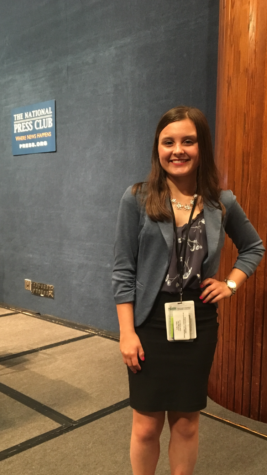Case Rally: What really happened?
December 3, 2017
Spectators at this year’s Case Rally felt their jaws drop as Somerset Berkley Regional High School principal David Lanczycki announced that the junior class had beat the seniors — an event that very rarely occurs at the annual pep rally.
“It’s always a surprise when the seniors don’t win. There’s always that romanticism where you want every senior class to have that moment,” Lanczycki says.
During last year’s Case Rally, the current juniors came in second while the current seniors came in third. “The difference with this Case Rally was,” Lanczycki says, “with the results of the year before, you knew there was a possibility of the juniors winning.”
This year, the results were, from last to first: freshmen, sophomores, seniors, juniors. The juniors and seniors were separated by a mere six points in one of the closest Case Rallies the school has ever seen.
Junior class president Ryan Silverman believes that the results of this year’s Case Rally were accurate because “both the juniors and the seniors had great skits but the juniors won because we had more Penny Pounds and, in my opinion, a slightly better skit.”
Senior class president Kara Kanuse says that the seniors’ “skit and props were the best. Also, we cheered every grade on and had little to no jokes because we didn’t want to be offensive. And our class banner couldn’t have been an inch bigger — it was 75 feet long! It covered our entire section. We did everything to try to get the maximum amount of points.”
The skits are scored on a rubric by a panel of five judges, who are teachers at SBRHS. The scoring guide includes three categories: artwork (10 points), class participation (10 points), and skit (30 points). In each of these categories, the class can score up to these maximum amount of points. More than one class can get the same amount of points for a certain category.
The final category is Penny Pounds, which is worth 10 points. Each class fundraises Penny Pounds and donates the money towards a cause. This year, fundraising for Penny Pounds began November 1. Unlike the other categories, this one is ranked, and therefore only the class that has the most Penny Pounds can get the maximum 10 points. After that, the class with the second highest amount gets eight points, the third gets 6 points, and the last gets 4 points.
The rubric totals 60 points per judge. Because there are five judges, the maximum amount of points a class can get is 300. Therefore, when the five judges combine their scores, artwork, class participation, and Penny Pounds is worth 50 points each and the skit is worth 150 points.
While the artwork, class participation, and skit are scored by the judges, the Penny Pounds are not added to the score until after the judges give their papers to Lanczycki. Therefore, the Penny Pounds do not affect the other categories when the judges are scoring them and the judges do not know how their fellow judges scored.
Though the judges’ score sheets for each class are confidential, Lanczycki says that, “looking at the scores, there were some judges that were total opposites where one person thought one skit was way better while another person thought a different skit was way better.”
Lanczycki says that the final results really came down to one group doing slightly better in some categories than the other groups because both the juniors and the seniors were so close this year.
Madison Kelley, a junior involved in Case Rally this year, says that the junior class “put in very long nights and a ton of practice into everything we did, so it was nice to see that everyone’s dedication and coming together paid off.”
However, Jamie Torres, a senior involved in Case Rally this year, says that she does not agree with the results because “the junior skit was not as great as it had the potential to be, comparing it to their great performance the previous year, when they should have won.”
This year, students at SBRHS raised a record amount of money from Penny Pounds: $10,142.70
All of the money will be donated to the school’s Best Buddies chapter that was started in July.
Lanczycki says that Penny Pounds was originally started at SB because “it was a way of trying to fundraise and give back to something more than themselves. It was a way of being a little less self-centered and a little more worldly.”
The juniors raised the most Penny Pounds this year at about $5,000, followed by the seniors at around $3,600.
Lanczycki says that Penny Pounds played the same role this year as it does every year. “Generally, the seniors get more money and there’s a lot of times where they win by seven or eight points because Penny Pounds put them over,” Lanczycki says. “It was different this year in who made the most money.”
This year, the junior class began fundraising for Penny Pounds in October, hosting a car wash on October 28, though the agreement for all classes was to start fundraising on November 1.
“The juniors started in October, which is not allowed,” Kanuse says. “I’m not coming up with excuses why we lost but if there are rules, they should be followed. They shouldn’t have been allowed to start before November 1 when every other grade didn’t.”
This year, Lanczycki says, “Penny Pounds did swing the scores.”
However, Lanczycki says that Penny Pounds works both ways. There have been some senior classes in the past that would have lost to the juniors had they not had the most Penny Pounds.
“The competition takes away the meaning from the cause,” Silverman says. “On the other hand though, getting rid of the competition would result in significantly less donations. This is an issue that will have to be addressed next year, whether it is making Penny Pounds a separate competition, limiting it to just coins like it used to be, or something else.”
This year, the decision was made to end the selling of senior class t-shirts for Penny Pounds.
The selling of class t-shirts for a Penny Pound profit had been started the previous school year without Lanczycki’s knowledge. Lanczycki says that it gave an unfair advantage to the senior class because the other grades could not do it.
“If one group gets to rob a bank and get away with it, does that mean that another group gets to rob that bank, or do you just stop that from happening?” Lanczycki says.
Though Lanczycki ended using money from selling the shirts for Penny Pounds, the seniors were still allowed to buy class t-shirts because it is a tradition.
However, many seniors point to the decision to end the selling of t-shirts for Penny Pounds this year as part of the reason why they did not raise more Penny Pounds than the juniors.
“The juniors didn’t sell t-shirts this year. The juniors raised more money and they didn’t have any advantage, so what would the problem be? How were the juniors able to do it and the seniors weren’t? They were more motivated and they found a way of raising more money,” Lanczycki says.
The seniors already have inherent privileges in Case Rally: they have already done it three years and they get to pick two judges whereas the other classes only get to pick one each. He says that this is as much of a senior privilege that they should have. He believes that the competition has to be fair to give everyone an equal opportunity.
“Every time a group loses, they want to look for some outside reason why that might have happened because ‘it’s not me.’ If you look at it, the juniors collected more money,” Lanczycki says. “The scoring of the skits was close but the judges went through it and gave their opinions. That’s their role as judges.”
Lanczycki says that the unfair advantage of selling senior class t-shirts for Penny Pounds outweighed the potential for more Penny Pounds pooled overall as a result of the senior class raising more money because, ultimately, the classes found other ways to fundraise money. This includes a movie night hosted by SBRHS, car washes, and a brand new Powder Puff tournament.
“I think this year really addressed an underlying issue with the Penny Pounds system,” Silverman says. “The t-shirt thing was ridiculous — it should have been allowed because it’s going to charity.”
Kanuse agrees: “The t-shirts were absolutely ridiculous, especially coming off of third place last year. Ultimately that rule that we can’t sell t-shirts not only hurt us, but also the charity because they could have gotten more money.”
Lanczycki says that his class lost Case Rally their senior year because the junior class raised more Penny Pounds. “Was it the junior class’s fault my senior year that they raised more Penny Pounds? Or was that on my class?” Lanczycki says.
During this year’s Case Rally, tensions between the junior and senior classes rose to an all-time high. The results of the previous year’s Case Rally as well as the equally intense determination of the junior and senior classes to win the rally this year caused hostilities to run high.
“The competition instilled from last year and the senior skit theme put more pressure on both classes and ultimately did no good for either grade with the mentality of trying to beat one another rather than focusing on beating Case,” Torres says.
“Case Rally this year was awful, ask anyone!” Kanuse says. “It did not bring our school together at all. My grades dropped, I didn’t sleep, I barely ate. I know for a fact I am not the only one. Everyone thought it wasn’t as much fun as usual because it was so competitive.”
However, tensions have recently decreased as the Case Rally rush has finally ended.
“I don’t think it comes down to deserving to win Case Rally. You could tell by all the performances all the grades did work incredibly hard,” Kelley says.
Lanczycki urges the seniors to “never let a finish line define something; it’s about your journey in anything. Learn to appreciate and learn from your journey, and the finish line doesn’t matter as much.”
He says that he is proud of the performance put on by both the juniors and the seniors.
“The juniors were so precise and so organized. It was almost like clockwork, watching them in rehearsal. But the seniors had so many more hurdles to jump over that they were able to, which made me so proud to see their work and their fight. I was really proud of all the grades,” Lanczycki says.



